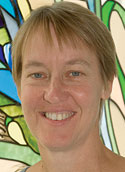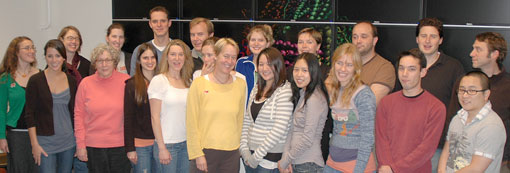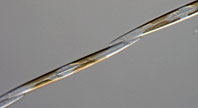 |
|||||||
| Ocean and Fishery Sciences Home Page | News | Make a Gift | |||||||
|
December 2008 | Return to issue home
Exploring the Wonders of the Tiny Diatom “With every fifth breath, thank a diatom,” Ginger Armbrust likes to say. Why? Because diatoms—tiny but ubiquitous one-celled organisms—are responsible for 20 percent of all photosynthesis on Earth, and photosynthesis creates oxygen. Thanks, diatoms!
A School of Oceanography professor, Armbrust headed the first project to sequence a diatom genome—Thalassiosira pseudonana—in collaboration with the Department of Energy Joint Genome Institute. Her laboratory was also involved in the sequencing a second diatom, Phaeodactylum tricornutum. Understanding diatoms is important for several reasons, according to Armbrust. They exist in unfathomable quantities in oceans, fresh water and even moist soil. To get an idea of how plentiful they are, think about this: collectively, they perform as much photosynthesis as all of the Earth’s terrestrial rain forests. Diatoms play a critical role in carbon cycling, fixing carbon dioxide (CO2) and releasing oxygen. They also cycle silicon, the second-most abundant element, after oxygen, in the Earth’s crust. As rocks weather and dissolve, they create silicic acid, which diatoms use to build their cell walls. When diatoms die and sink, they form vast deposits of what Armbrust calls “diatomaceous ooze.” Eventually, this becomes diatomaceous earth, which consists of the fossilized remains of diatoms and has several practical uses: for filtration, as an absorbent for liquids, as an activator in blood clotting studies and even as a component of dynamite. The organic matter from ancient diatoms, buried for eons, is also responsible for much of the world’s petroleum deposits. Ironically, as the world burns petroleum and pumps carbon dioxide into the air, diatoms are crucial to pulling it out of the atmosphere. There has even been discussion, according to Armbrust, of using diatoms to fight global warming by fertilizing the ocean to create diatom blooms. The organisms would absorb CO2 and eventually die and sink, taking the CO2 with them. “But that’s a very controversial idea,” Armbrust says. “What would the effects be on the ocean ecosystem? It’s just one more reason to understand how diatoms function. They’re very important organisms.” She calls them Earth’s “unsung heroes.” They are also “beautiful to look at,” Armbrust notes. Different species can be identified by the intricate structure of their silica walls, and the variety is incredible. Armbrust estimates a minimum of 20,000 species of diatoms—the most of any eukaryotic organism in the ocean. But she cautions that science is probably “woefully underestimating their diversity.”
The general work of Armbrust’s 25-person lab, which includes 8 undergraduates, 5 graduate students and 3 post-docs in the Benjamin Hall Interdisciplinary Research Building, concerns microbial communities in the ocean and how they interact and respond to changes in the environment. Her team studies harmful algal blooms and other issues related to oceans and human health. “We need to know more about how diatoms function and the basis for their successful ecological role. So we’re combining studies—genomics, physiological, biological and field studies—to gain insight into how they work.” Diatoms, she says, likely evolved about 180 million years ago. “The world was very different then. There were probably no polar ice caps, for example. Naturally, the ocean has changed since then, but it’s changing very rapidly now. What are the impacts? Diatoms require many trace elements. We need to know more about the complicated chemical interactions that are occurring in the ocean and how organisms like diatoms are adapting.”
Take Pseudo-nitzschia, for example. This small subset of diatoms can produce the neurotoxin domoic acid. Shellfish that feed on this algae are not harmed, but humans and animals that eat the shellfish can suffer serious or even fatal illness. “This phenomenon was not known until the mid-1980s,” she says. “Why not? Is it related to changing ocean chemistry? At a time when people are building a greater dependence on products from the ocean, it’s an important thing to study.” Pseudo-nitzschia is one of the diatoms Armbrust’s lab is sequencing. “Sequencing can tell us what the capabilities of an organism are. In Pseudo-nitzschia, we could identify the genes involved in toxin production and possibly identify the stage at which the organism was getting ready to produce the toxin. Eventually, this could lead to some sort of early warning system.” “Genomes give you the parts list, and if we can tease out this information from genomes—which genes are important, what they do—we could use them as sensors in the field and allow the organisms themselves to tell us what’s happening in the environment. They could be our most sensitive canaries in the coal mine.” Sidebar: Learn more about Benjamin Hall *Photos courtesy of Ginger Armbrust December 2008 | Return to issue home | |||||||
|
|||||||



